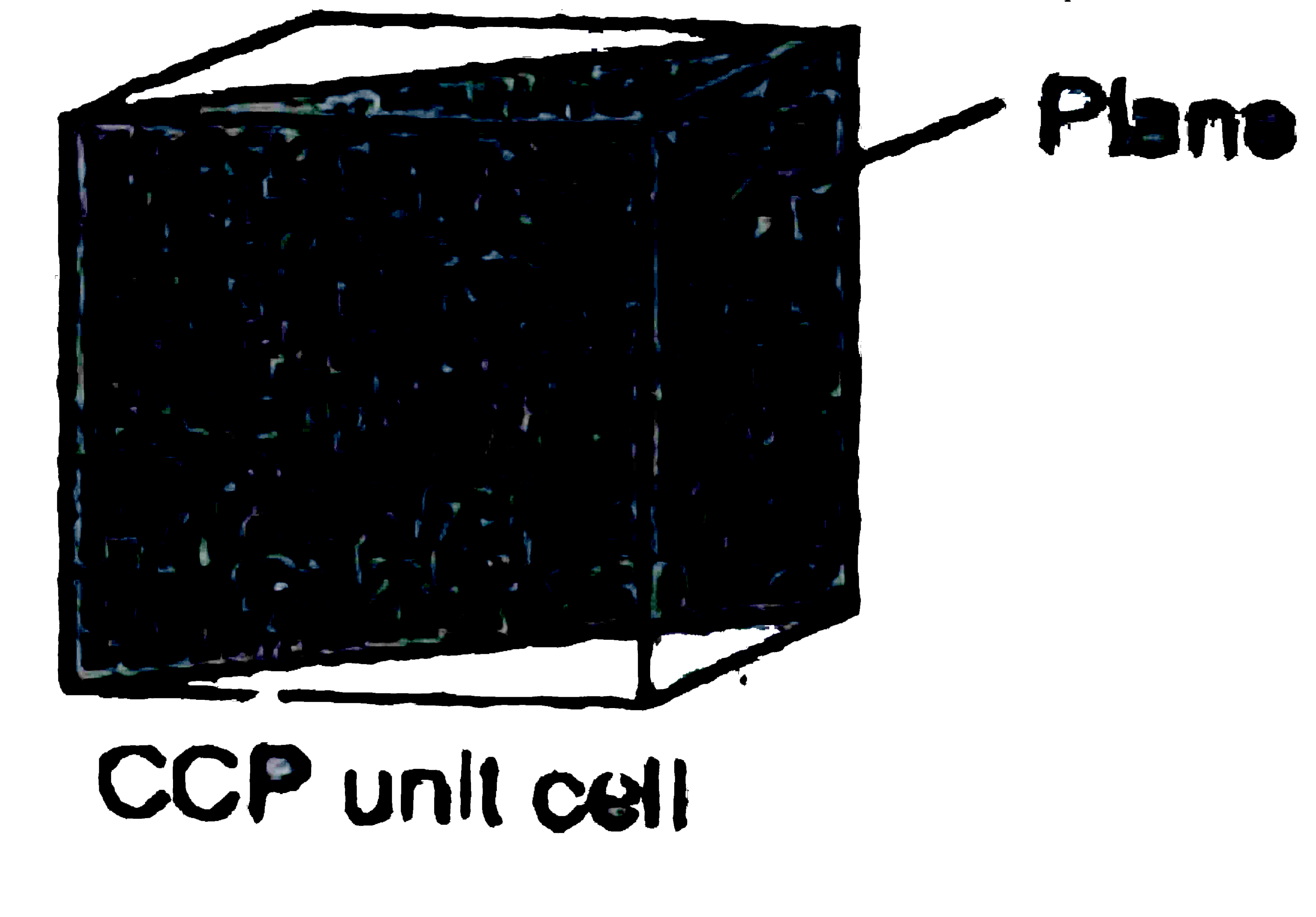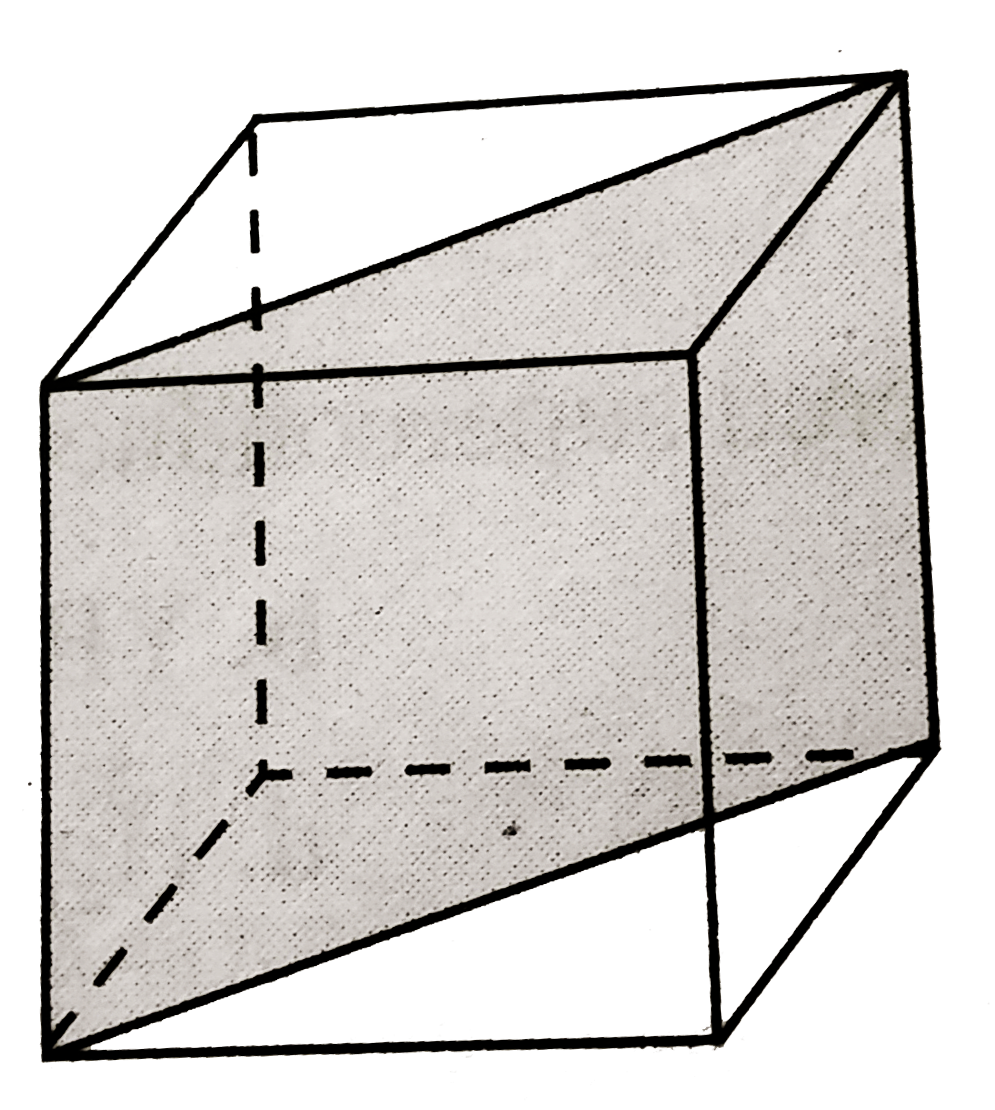Oxygen atom forms FCC unit cell with 'A ' atoms occupying all tetrahedral voids and 'B ' atoms occupying all octahedral voids. If atoms are removed from two of the body diagonals then determine the formula of resultant compound formed .
A4B4O7
A8B6O7
A8B8O7
A6B8O6
The correct Answer is:B
To determine the formula of the resultant compound formed when atoms are removed from two body diagonals in a face-centered cubic (FCC) unit cell, we can follow these steps:
Step 1: Determine the number of oxygen atoms in the FCC unit cell
In an FCC unit cell, the number of atoms can be calculated as follows:
- There are 8 corner atoms, each contributing 18 of an atom to the unit cell.
- There are 6 face-centered atoms, each contributing 12 of an atom to the unit cell.
So, the total number of oxygen atoms (O) in the FCC unit cell is:
Total O=8×18+6×12=1+3=4
Step 2: Determine the number of tetrahedral and octahedral voids
- The number of tetrahedral voids in an FCC unit cell is given by 2n, where n is the number of atoms in the unit cell. Here, n=4, so:
Tetrahedral voids=2×4=8
- The number of octahedral voids in an FCC unit cell is equal to n, so:
Octahedral voids=4
Step 3: Occupation of voids by A and B atoms
- All tetrahedral voids are occupied by A atoms, so there are 8 A atoms.
- All octahedral voids are occupied by B atoms, so there are 4 B atoms.
Step 4: Removing atoms from the body diagonals
- Each body diagonal has 2 atoms in tetrahedral voids. Since we are removing atoms from 2 body diagonals, we remove a total of:
2×2=4 A atoms
- After removing these A atoms, the remaining A atoms are:
8−4=4 A atoms
- Each body diagonal also passes through an octahedral void, so we remove 1 B atom from the octahedral void. The remaining B atoms are:
4−1=3 B atoms
Step 5: Calculate the remaining atoms
- The remaining atoms are:
- A: 4
- B: 3
- O: The total number of O atoms was 4, and we did not remove any O atoms, so it remains 4.
Step 6: Write the formula of the resultant compound
Now, we have:
- A: 4
- B: 3
- O: 4
To express this in the simplest whole number ratio, we can write:
A4B3O4
Final Result
The formula of the resultant compound formed is:
A4B3O4
In an FCC unit cell, the number of atoms can be calculated as follows:
- There are 8 corner atoms, each contributing 18 of an atom to the unit cell.
- There are 6 face-centered atoms, each contributing 12 of an atom to the unit cell.
Total O=8×18+6×12=1+3=4
- The number of tetrahedral voids in an FCC unit cell is given by 2n, where n is the number of atoms in the unit cell. Here, n=4, so:
Tetrahedral voids=2×4=8
- The number of octahedral voids in an FCC unit cell is equal to n, so:
Octahedral voids=4
- All tetrahedral voids are occupied by A atoms, so there are 8 A atoms.
- All octahedral voids are occupied by B atoms, so there are 4 B atoms.
- Each body diagonal has 2 atoms in tetrahedral voids. Since we are removing atoms from 2 body diagonals, we remove a total of:
2×2=4 A atoms
- After removing these A atoms, the remaining A atoms are:
8−4=4 A atoms
- Each body diagonal also passes through an octahedral void, so we remove 1 B atom from the octahedral void. The remaining B atoms are:
4−1=3 B atoms
- The remaining atoms are:
- A: 4
- B: 3
- O: The total number of O atoms was 4, and we did not remove any O atoms, so it remains 4.
Now, we have:
- A: 4
- B: 3
- O: 4
A4B3O4
The formula of the resultant compound formed is:
A4B3O4
Similar Questions
In a hypothetical solid C atoms form C C P lattice with A atoms occupying all the Tetrahedral Voids and B atoms occupying all the octahedral voids A and B atoms are of the appropriate size such that there is no distortions in the CCP lattice. Now if a plane is cut ( as shown ) then the section would like

View SolutionIn a ccp structure of X atoms, Y atoms occupy all the octahedral holes. If 2X atom are removed from corners and replaced by Z, then the formula of the compound will be
View SolutionIn a hypothetical solid, C atoms are found to form cubical close-packed lattice. A atoms occupy all tetrahedral voids and B atoms occupy all octahedrals voids.

A and B atoms are of appropriate size, so that there is no distortion in the p lattice of C atoms. Now if a plane as shown in the following figure is cut, then the cross section of this plane will look like
View SolutionIn a hypothetical solid, C atoms are found to form cubical close-packed lattice. A atoms occupy all tetrahedral voids and B atoms occupy all octahedrals voids.

A and B atoms are of appropriate size, so that there is no distortion in the p lattice of C atoms. Now if a plane as shown in the following figure is cut, then the cross section of this plane will look like
View SolutionA forms ccp lattice B occupy half of the octahedral voids and O occupy all the tetrahedral voids. Calculate formula-
View SolutionA solid is formed and it has three types of atoms X, Y and Z, X forms a fcc lattice with Y atoms occupying all tetrahedral voids and Z atoms occupying half of octahedral voids. The formula of solid is :-
View SolutionA crystal is made of particles X,Y and Z.X form fcc packing . Y occupies all the octahedral void of X and Z occupies all the tetrahedral voids of X . If all the particles along one body diagonal are removed then the formula of the crystal would be:
View SolutionIn a crystalline solid, atoms of X form fcc packing and atoms of Y occupy all octahedral voids. If all the atoms along one body diagonal are removed, what is the simplest formula of the crystalline lattice solid?
View SolutionElement 'B' forms p structure and 'A' occupies half of the octahedral voids, while oxygen atoms occupy all the tetrahedral voids. The structure of bimetallic oxide is:
View SolutionA solid is formed and it has three types of atoms X, Y, Z. X forms an FCC lattice with Y atoms occupying one-fourth of tetrahedral voids and Z atoms occupying half of the octahedral voids. The formula of the solid is
View Solution
